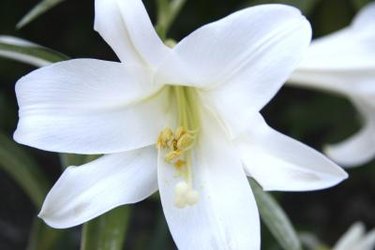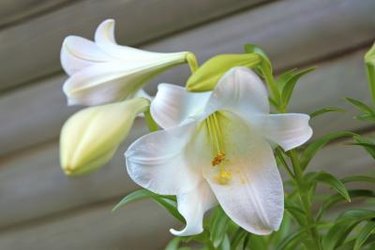
Although they are not difficult to keep, an indoor lily does require a little bit of extra attention in order to thrive. A place with just enough light, proper moisture and regular fertilizing are critical for an indoor lily, but it pays dividends with striking foliage, beautiful flowers and air purification. While there are several types of popular indoor lilies, such as Peace, Calla and Arum, the same basic care principles apply to all varieties.
Step 1

Choose a location for your lily that is out of direct sun and not subject to frequent temperature changes. While an indoor lily will grow in low or artificial light, it will do best in a location with indirect sunlight. Also, look for a spot that is out of the way of drafts and stays fairly warm. Indoor lilies prefer temperatures that stay between 65 and 85 degrees F, without any rapid fluctuations.
Video of the Day
Step 2

Transplant your lily into a regular container or pot if it is in a temporary plastic pot. Fill the pot with potting soil mixed with an equal amount of perlite to create a light planting mixture that drains easily and won't compact.
Step 3

Water thoroughly, but allow the soil to nearly dry out between waterings. After watering, check the bottom of the pot to make sure water is draining and the lily is not sitting in soggy or over-saturated soil. Soggy conditions can kill an indoor lily. Also, make sure the water is at least room temperature and is not cold.
Step 4

Fertilize with a 20-20-20 liquid fertilizer designed for houseplants every three months during the winter and every two weeks during the summer for optimum blooms. If your plant is not ready to flower, or you prefer fewer blooms, fertilize once a month year-round. If leaves begin turning brown, reduce the amount of fertilizer.
Step 5

Remove any dead or damaged leaves as they occur, as well as faded blooms, by cutting at the base of the stem. No other pruning is necessary.
Video of the Day